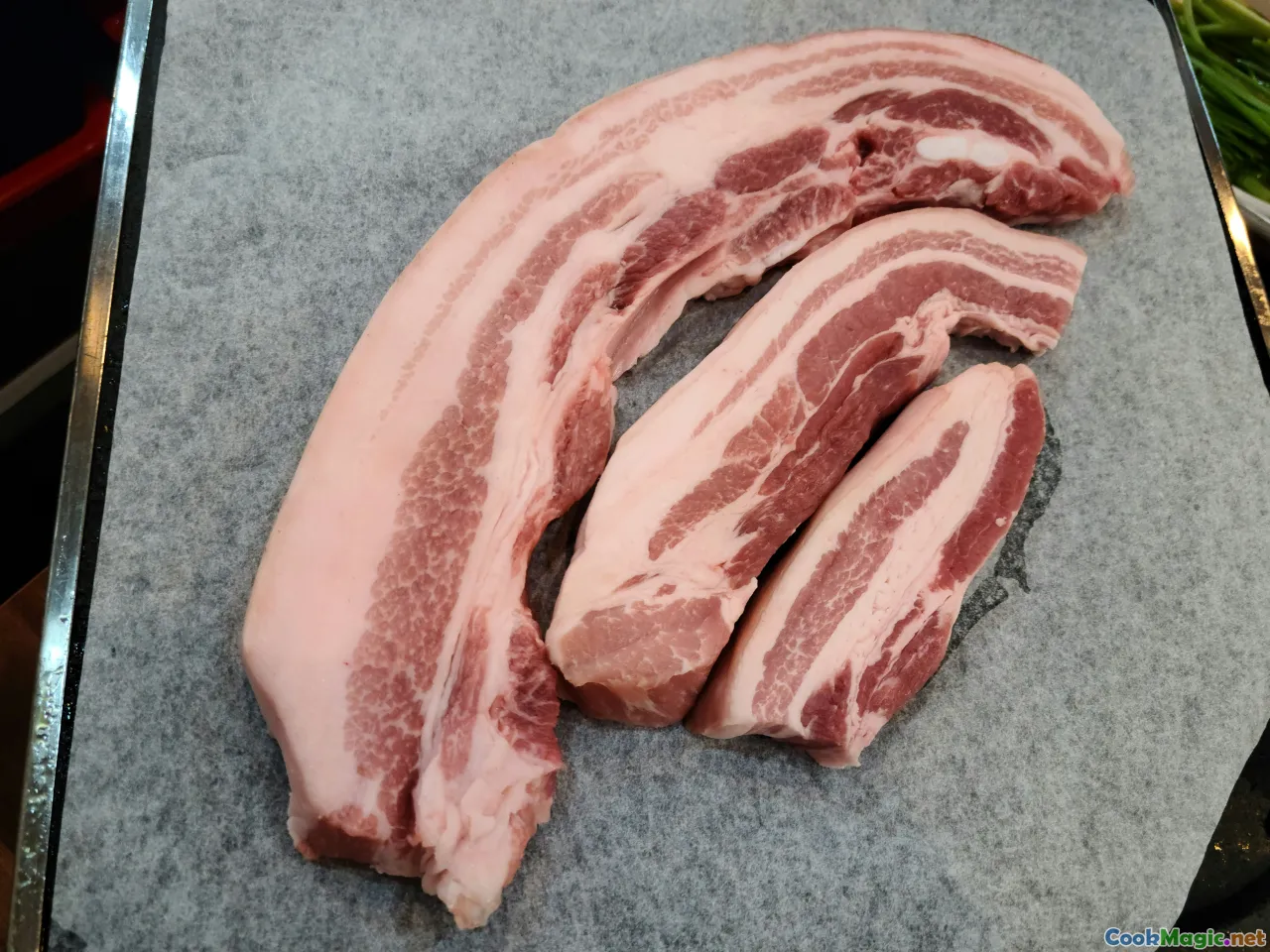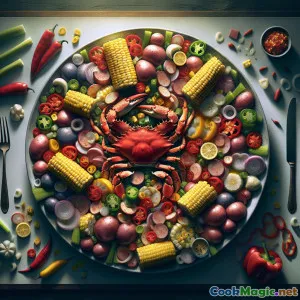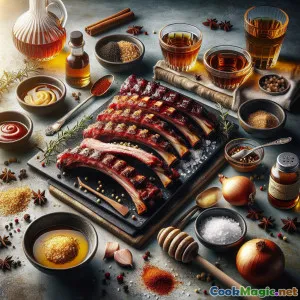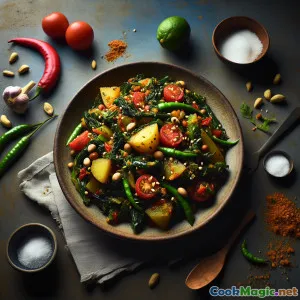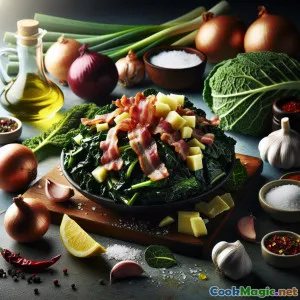
Rau chân vịt kiểu Nam Mỹ xào với thịt xông khói giòn
(Southern Skillet Collard Greens with Crispy Bacon)
(0 Đánh giá)0
864
tháng 7 16, 2025
Báo cáo sự cố
Nguyên liệu
-
500 grams Rau cải xanh
(Lá tươi, bỏ thân dày và thái nhỏ)
-
150 grams Thịt xông khói
(Hun khói, cắt thành miếng nhỏ)
-
1 medium Hành vàng
(Cắt nhỏ mịn)
-
3 cloves Tỏi
(Băm)
-
2 tbsp Giấm táo
(Mang lại sự tươi sáng cho rau xanh.)
-
400 ml nước dùng gà
(Có thể thay thế bằng nước dùng rau cho tùy chọn ăn chay.)
-
1 tbsp Dầu ô liu
(Nâng cao hương vị, đặc biệt để làm giòn thịt xông khói.)
-
0.5 tsp Bột ớt đỏ
(Tùy chọn, để thêm một chút vị cay nhẹ.)
-
0.5 tsp Muối
(Nếm thử và điều chỉnh theo khẩu vị.)
-
0.5 tsp Hạt tiêu đen
(Tiêu được giã hoặc xay mới)
(Lá tươi, bỏ thân dày và thái nhỏ)
(Hun khói, cắt thành miếng nhỏ)
(Cắt nhỏ mịn)
(Băm)
(Mang lại sự tươi sáng cho rau xanh.)
(Có thể thay thế bằng nước dùng rau cho tùy chọn ăn chay.)
(Nâng cao hương vị, đặc biệt để làm giòn thịt xông khói.)
(Tùy chọn, để thêm một chút vị cay nhẹ.)
(Nếm thử và điều chỉnh theo khẩu vị.)
(Tiêu được giã hoặc xay mới)
Dinh dưỡng
- Khẩu phần: 4
- Kích thước khẩu phần: 1 bát (200g)
- Calories: 195 kcal
- Carbohydrates: 10 g
- Protein: 11 g
- Fat: 12 g
- Fiber: 4 g
- Sugar: 2 g
- Sodium: 550 mg
- Cholesterol: 25 mg
- Calcium: 130 mg
- Iron: 1.8 mg
Hướng dẫn
-
1 - Chuẩn bị cải bẹ xanh:
Loại bỏ phần cuống dày của cải bẹ xanh. Rửa sạch kỹ càng, sau đó xếp chồng, cuộn lại và cắt lá thành những sợi mỏng.
-
2 - Làm giòn thịt xông khói:
Thêm dầu ô liu vào chảo lớn ở lửa vừa. Rán các miếng thịt xông khói cho đến khi giòn, khoảng 5–7 phút. Lấy chúng ra bằng muỗng có lỗ và để sang một bên, để lại mỡ đã tiết ra trong chảo.
-
3 - Xào hành tây và tỏi:
Thêm hành được cắt nhỏ vào chảo có mỡ bacon. Xào cho hành mềm, khoảng 3 phút, sau đó cho tỏi vào và xào thêm 1 phút cho thơm.
-
4 - Nấu cải bẹ xanh:
Thêm lá collard vào chảo. Xoay để phủ đều, và nấu 2–3 phút. Đổ nước dùng gà, đun ở mức sôi lăn tăn, đậy lại, nấu 10–12 phút, thỉnh thoảng khuấy, cho đến khi lá mềm.
-
5 - Nêm gia vị và thêm thịt xông khói.:
Loại bỏ nắp. Khuấy vào giấm táo, ớt đỏ vụn (nếu dùng), muối và tiêu đen. Trả thịt xông khói vào chảo và khuấy đều mọi thứ. Đun nhỏ lửa không đậy cho đến khi phần lớn chất lỏng bay hơi.
-
6 - Phục vụ:
Nếm cho vừa miệng, sau đó chuyển cải bẹ xanh với thịt xông khói vào các bát phục vụ. Dọn nóng làm món phụ hoặc bữa trưa no đủ.
Loại bỏ phần cuống dày của cải bẹ xanh. Rửa sạch kỹ càng, sau đó xếp chồng, cuộn lại và cắt lá thành những sợi mỏng.
Thêm dầu ô liu vào chảo lớn ở lửa vừa. Rán các miếng thịt xông khói cho đến khi giòn, khoảng 5–7 phút. Lấy chúng ra bằng muỗng có lỗ và để sang một bên, để lại mỡ đã tiết ra trong chảo.
Thêm hành được cắt nhỏ vào chảo có mỡ bacon. Xào cho hành mềm, khoảng 3 phút, sau đó cho tỏi vào và xào thêm 1 phút cho thơm.
Thêm lá collard vào chảo. Xoay để phủ đều, và nấu 2–3 phút. Đổ nước dùng gà, đun ở mức sôi lăn tăn, đậy lại, nấu 10–12 phút, thỉnh thoảng khuấy, cho đến khi lá mềm.
Loại bỏ nắp. Khuấy vào giấm táo, ớt đỏ vụn (nếu dùng), muối và tiêu đen. Trả thịt xông khói vào chảo và khuấy đều mọi thứ. Đun nhỏ lửa không đậy cho đến khi phần lớn chất lỏng bay hơi.
Nếm cho vừa miệng, sau đó chuyển cải bẹ xanh với thịt xông khói vào các bát phục vụ. Dọn nóng làm món phụ hoặc bữa trưa no đủ.
Thông tin thêm về: Rau chân vịt kiểu Nam Mỹ xào với thịt xông khói giòn
Collard Greens with Bacon — Southern Tradition in Every Bite
Collard greens have a deeply rooted history in Southern American cuisine, stretching back over generations and oceans. Originating in Africa and Europe, leafy greens like collards became staple crops across the southern United States due to their resilient nature and hearty, nutritious leaves. Collard greens with bacon is an iconic dish—earthy greens slow-simmered until melt-in-your-mouth tender, enriched with smoky bacon, sweet onions, and spiked with a splash of vinegar to balance the richness.
History & Cultural Significance
For enslaved African Americans residing in the Antebellum South, collards were cultivated in gardens as essential sources of nutrition. Traditionally, they were slow-cooked with smoked meats (ham hocks, fatback, or bacon) to bring extra body and warmth, flavors that became emblematic of African American and Southern cuisine. Every Black family, and indeed, many white households in places like Georgia, the Carolinas, and Alabama developed their own approaches to seasoning, braising, and serving collard greens, often with personal or regional flourishes.
The custom of adding vinegar reflects West African cooking traditions, where acid is often used to brighten the intensity of long-cooked stews. Even today, a jar of peppered vinegar frequently sits on the table alongside greens.
Personal Tips & Notes
- Prepping the Greens: Always remove the thick center ribs—these don't tenderize well and can add unwanted bitterness. For speed, try stacking several leaves, rolling tightly, and slicing into 'chiffonade' style ribbons.
- Choosing Bacon: Use high-quality, smoky bacon for depth. Alternatively, try adding chopped smoked sausage or a ham hock for even more flavor, or opt for a plant-based bacon or smoked tofu for a vegetarian version.
- Simmering Liquid: Chicken stock gives a rounded base, but if making vegetarian, try mushroom or vegetable stock with a splash of smoked paprika.
- Final Touch: The table vinegar is traditional—pass a small bottle for diners wishing to add extra tang. Vinegar can cut through the greens' natural brassica bitterness and bacon's richness at the last second.
- Leftovers & Storage: These collard greens taste even better the next day. Refrigerate in an airtight container and enjoy within three days. Reheat gently over the stove with a splash of water or stock to restore moisture.
Creative Variations
For an intriguing, creative spin, add chopped sun-dried tomatoes or a pinch of brown sugar at the end for sweetness, or toss in a can of drained white beans to make a complete one-skillet meal. Chopped jalapeños roasted with bacon briefly or a sprinkle of toasted pecans over the top brings new depths and crunch. Steep collards in miso-infused broth for a unique global twist.
Beyond the Side — Serving Ideas
While classic Southern plates offer collards alongside cornbread, barbecue meats, or fried chicken, don’t hesitate to serve these as a main element for lunch over cheesy grits, as part of a rice bowl, or folded into a breakfast sandwich with egg. Their savory and comforting taste profile brings a warm balance at any time of day.
Quick Nutrition Glimpse
Collards bring potent doses of vitamins A, C, and K, calcium, and dietary fiber, supporting strong bones and digestion. Coupled with protein and healthy fats from bacon, this dish is a filling source of comfort-food nutrition.
The joyous blend of old-world culinary knowledge refined on this continent makes collard greens with bacon more than a recipe—it’s a celebration of history, resourcefulness, and flavor. Whether you grew up alongside a pot of simmering greens or you’re trying this Southern mainstay for the very first time, you’re partaking in a beloved legacy that links countless kitchens across centuries.


